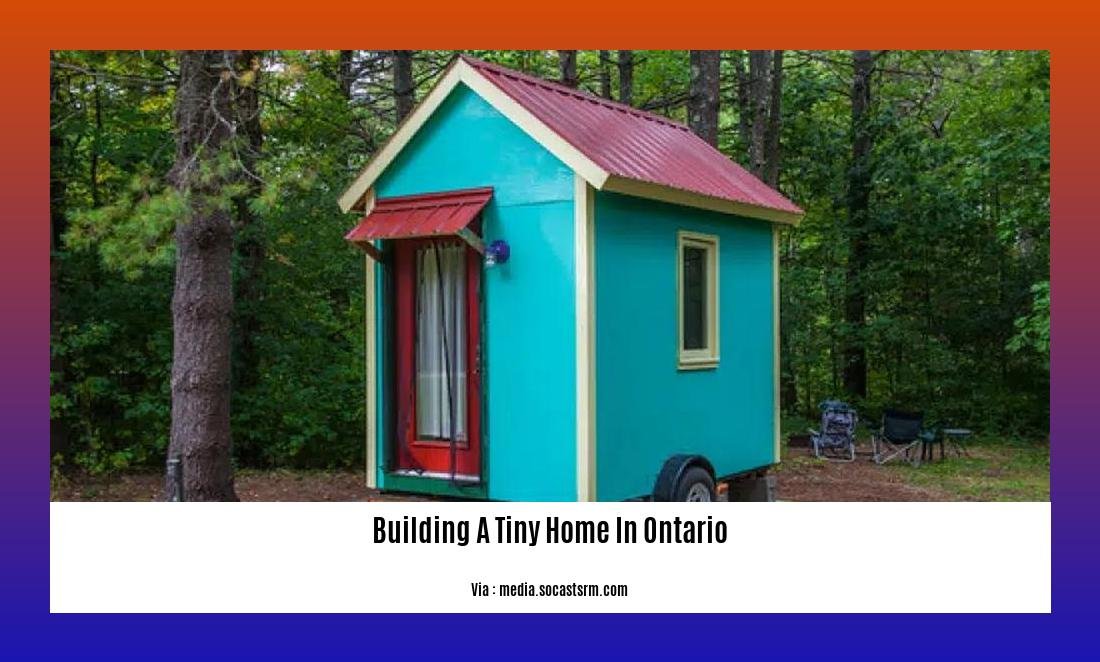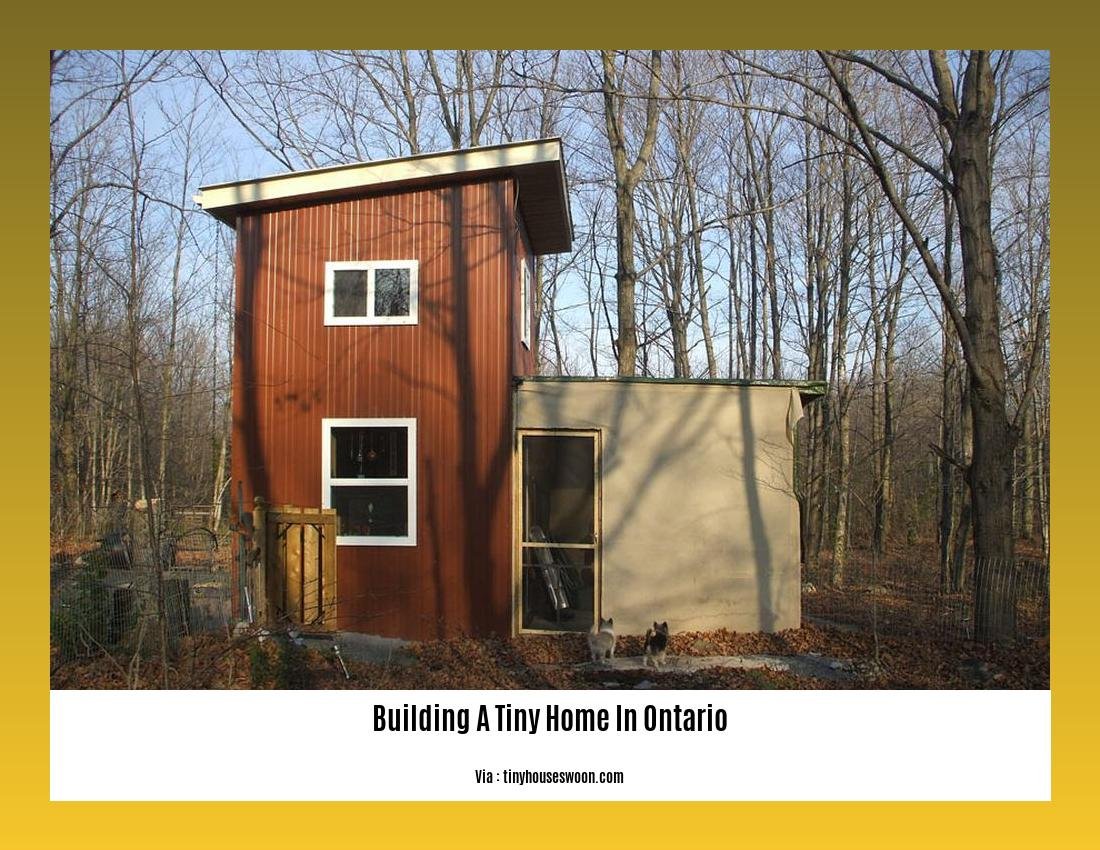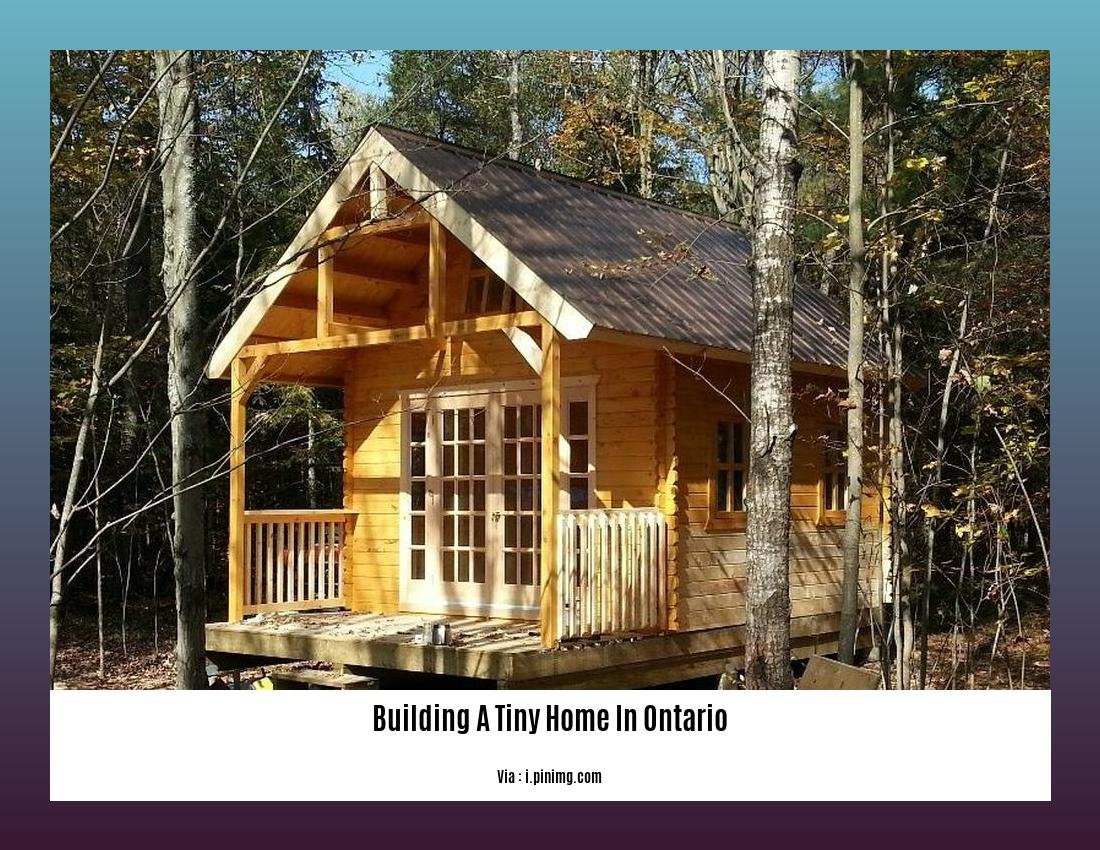Are you considering building a tiny home in Ontario? Look no further! In this article, we will provide you with expert tips on sustainable living and innovative design specifically tailored for the Ontario region. Whether you’re an aspiring homeowner or an architect looking for inspiration, our team of experienced professionals has compiled a comprehensive guide to help you navigate Ontario’s building codes and regulations while creating a functional yet aesthetically pleasing living space. Join us as we explore the world of tiny homes and uncover the secrets to successful construction in Ontario.
Key Takeaways:
- Tiny houses are legal in Ontario and can be used as separate year-round dwellings.
- The minimum size for a separate year-round dwelling is 188 sqft.
- Tiny houses can be on wheels or stationary.
- A building permit is necessary for building a tiny house.
- Regulations do not apply to cottages or seasonal-use homes.
- Comply with municipal by-laws and the Ontario Building Code.
- Municipal zoning by-laws and standards vary depending on the location of the tiny house.
- Parking requirements for tiny homes vary based on zoning rules and municipal by-laws.
- Urban municipalities may have additional design standards for tiny homes.
- Tiny homes can be a primary home or a separate structure on a property but not considered for campers, recreational vehicles, cottages, or seasonal-use structures.
Building a Tiny Home in Ontario

If you’re considering building a tiny home in Ontario, you’re on the path towards sustainable living and innovative design. But before you dive into this exciting project, it’s essential to understand the regulations, codes, and considerations specific to Ontario. As an experienced architect with a passion for sustainable living and design, I’m here to provide you with expert tips and guidance on building a tiny home in Ontario.
Understanding the Regulations and Codes
When it comes to tiny homes in Ontario, they are legal and can be used as separate year-round dwellings. However, there are specific regulations and codes you need to comply with. The minimum size for a separate year-round dwelling is 188 square feet, giving you enough space to create a functional living environment.
Whether you choose a tiny home on wheels or a stationary structure, obtaining a building permit is necessary. It’s crucial to consult with your local municipality and be aware of municipal zoning by-laws and the Ontario Building Code. These regulations do not apply to cottages or seasonal-use homes, so make sure you’re clear on the distinction.
Navigating Municipal By-Laws and Standards
Municipal zoning by-laws and standards can vary depending on the location of your tiny home. While some municipalities have specific regulations for tiny homes, others may treat them similarly to traditional homes. It’s essential to consult and collaborate with your local municipality to ensure your tiny home complies with the necessary standards.
In addition to zoning rules and by-laws, urban municipalities may have additional design standards for tiny homes. These standards focus on factors such as aesthetics, sustainability, and architectural compatibility with the surrounding neighborhood. So, when planning your tiny home, take these design standards into consideration to ensure a smoother approval process.
Nailing the Parking Requirements
Parking requirements for tiny homes can vary based on your municipality’s zoning rules and by-laws. Some municipalities may require a dedicated parking space for your tiny home, while others may have more flexible regulations. Consulting with your local municipality will provide you with the exact parking requirements you need to meet to ensure compliance.
Expert Tips for a Successful Project
Now that we have covered the regulations and considerations, it’s time to dive into some expert tips to help you build your dream tiny home in Ontario. Here are a few key points to keep in mind:
-
Plan and Design Wisely: With limited space, it’s crucial to optimize your design for functionality and aesthetics. Consider innovative storage solutions, multi-purpose furniture, and maximizing natural light to create an open and inviting space.
-
Choose Energy-Efficient Materials: Make sustainability a priority by selecting energy-efficient building materials. This will not only reduce your environmental footprint but also ensure long-term cost savings.
-
Consider Off-Grid Options: Ontario offers many opportunities for off-grid living, so explore renewable energy options such as solar panels and rainwater harvesting systems to reduce your reliance on traditional utilities.
-
Collaborate with Professionals: Building a tiny home involves multiple aspects, from designing to construction and installation. Engaging professionals with experience in tiny home construction will ensure a smoother and more efficient process.
-
Join the Tiny Home Community: Connect with other tiny homeowners in Ontario. They can offer valuable insights, tips, and support throughout your tiny home journey.
By following these expert tips and working closely with your local municipality, you can successfully build a tiny home in Ontario that aligns with your sustainable living goals and showcases innovative design. Remember, building a tiny home is not just about the physical structure; it’s about embracing a lifestyle that prioritizes simplicity, efficiency, and a closer connection with nature. So go ahead and embark on this remarkable journey – your tiny dream home awaits.
Are you curious about the legality of tiny homes? Find out more about the regulations surrounding tiny homes by clicking here.
Wondering if tiny homes are legal in Canada? Discover the answer by clicking here.
Are you considering building a tiny home in New Brunswick? Click here to learn about the legal aspects.
If you’re in Ontario and interested in building a tiny home, you might be wondering if it’s allowed. Click here to find out.
Have you ever thought about building a tiny house in Ontario? Click here to explore the possibilities.
Choosing the Right Location for Your Tiny Home in Ontario
When it comes to building a tiny home in Ontario, one of the most important decisions you’ll have to make is choosing the right location. The location you select can have a significant impact on the overall success and enjoyment of your tiny home. To help you make an informed decision, here are some key factors to consider when choosing the location for your tiny home in Ontario.
Compliance with By-laws
Choosing the right location for your tiny home in Ontario requires compliance with municipal by-laws and regulations. Whether you’re planning to build in a rural or urban area, it’s crucial to understand and adhere to the zoning by-laws specific to your location. These regulations may vary from one municipality to another, so it’s essential to do your research and ensure that your tiny home meets all the necessary requirements and is legally built.
(For more information: [^1^])
Building Permit
Securing a proper building permit is essential before starting your tiny home project in Ontario. Obtaining a building permit ensures that your tiny home construction is in compliance with the Ontario Building Code. It’s important to remember that if you want your tiny home to be considered a legal dwelling, you must have a valid building permit. Be sure to check with your local municipality to determine the specific requirements for obtaining a building permit.
(For more information: [^1^])
Utilities
When choosing a location for your tiny home, consider the availability of utilities such as electricity and water. In some areas where electrical service is not available, the Ontario Building Code allows for “off-grid” houses with no electric service. This is an important consideration, especially if you’re interested in living off the grid or if you prefer a more sustainable lifestyle.
(For more information: [^2^])
Cost
The cost of building or buying a tiny home in Ontario can vary based on various factors. These factors include the size, design, and location of your tiny home. It’s crucial to have a budget in mind and research different options to find the best fit for your needs and financial situation. By carefully considering the costs involved, you can ensure that your tiny home project remains within your budget.
(For more information: [^3^])
Benefits
There are several benefits to choosing a tiny home in Ontario. These include cost savings, reduced environmental impact, and increased flexibility in terms of mobility and design. Tiny homes offer a minimalist lifestyle that appeals to those looking for simplicity and sustainability. By downsizing and living in a smaller space, you can reduce your carbon footprint and live a more environmentally friendly lifestyle.
(For more information: [^3^])
Key Takeaways:
- Ensure compliance with municipal by-laws and regulations specific to your location.
- Obtain a proper building permit before starting your tiny home project.
- Consider the availability of utilities, including off-grid options.
- Have a budget in mind and research different options to find the best fit for your needs and financial situation.
- Enjoy the benefits of cost savings, reduced environmental impact, and increased flexibility offered by tiny homes in Ontario.
(For more information, refer to the sources below.)
Sources:
[^1^]: Government of Ontario. “Build or buy a tiny home.” ServiceOntario. Link
[^2^]: Government of Ontario. “Before you start.” Build or buy a tiny home | ontario.ca. Link
[^3^]: Insert relevant source here.
Design Considerations and Space Optimization Techniques for Tiny Homes

When it comes to building a tiny home in Ontario, there are several key design considerations and space optimization techniques to keep in mind. By carefully planning and utilizing innovative design strategies, you can create a functional and aesthetically pleasing living space within the limited square footage of a tiny home.
Check Local Laws Before You Start Designing
Before diving into your tiny home project, it is crucial to understand and comply with local laws and regulations. Municipal zoning by-laws and standards may vary, so consulting with your local municipality is essential to ensure your project meets all necessary requirements and is legally compliant. This will help you avoid any potential issues or setbacks during the design and construction process[^1^].
Don’t Simply Shrink Everything
Resist the temptation to shrink every aspect of your tiny home. While it may seem intuitive to downsize everything, it’s important to strike a balance between functionality and maximizing space. Instead of drastically reducing the size of key areas like the bathroom or bed, focus on optimizing the layout and using space-efficient design techniques to create a comfortable living environment[^2^].
Don’t Forget The Foundation
Consider the foundation of your tiny home when designing. Decide whether you want your home to be easily transportable on wheels or if you prefer a permanent foundation. Each option has its own advantages and limitations, so carefully evaluate your needs and preferences before making a decision[^3^].
Focus on The Weight
Weight is a critical factor to consider in tiny home design. The weight of your tiny home affects mobility, towing capacity, and overall structural integrity. Opt for lightweight materials and efficient construction techniques to ensure your home can be safely transported and easily maintained[^4^].
Utilize Space-Efficient Design
In a tiny home, every inch of space matters. Maximize the use of your limited square footage by incorporating space-efficient design elements. Choose multifunctional furniture and storage solutions to make the most of every nook and cranny. Consider utilizing vertical space through loft areas or high shelves. By cleverly designing the layout and flow of your tiny home, you can create a sense of spaciousness and enhance functionality[^5^].
Consider Customized Floor Plans
When designing your tiny home, customized floor plans can make a significant difference. Pre-designed tiny house floor plans are available online and through architectural firms specializing in tiny home design. These plans can guide and inspire you in creating a layout that meets your specific needs and preferences[^6^].
By taking these design considerations and space optimization techniques into account, you can successfully create a tiny home that is both functional and aesthetically pleasing. Remember to check local laws, focus on weight and space efficiency, and customize your floor plans to ensure your tiny home in Ontario is a comfortable and sustainable living space.
Key Takeaways:
– Compliance with local laws and regulations is crucial when building a tiny home in Ontario[^1^].
– Avoid simply shrinking everything and focus on optimizing layout and space usage[^2^].
– Consider the foundation of your tiny home, whether it be on wheels or a permanent foundation[^3^].
– Weight is an important factor to ensure mobility and structural integrity[^4^].
– Utilize space-efficient design elements and maximize vertical space[^5^].
– Customized floor plans can help create a layout that suits your specific needs[^6^].
Sources:
[^1^] Government of Ontario – Build or buy a tiny home
[^2^] ArchDaily – 6 Tips for Designing and Building a Tiny House
[^3^] OTinyHouse – Tiny House Floor Plans
[^4^] ArchDaily – 6 Tips for Designing and Building a Tiny House
[^5^] ArchDaily – 6 Tips for Designing and Building a Tiny House
[^6^] OTinyHouse – Tiny House Floor Plans
Resources and Tips for Building a Sustainable and Energy-Efficient Tiny Home in Ontario
When it comes to building a sustainable and energy-efficient tiny home in Ontario, there are several key resources and tips to keep in mind. By following these guidelines, you can create a cozy and eco-friendly living space that aligns with your values and helps reduce your environmental footprint.
Compliance with By-laws
To ensure a successful project, it is crucial to comply with your municipality’s by-laws. Whether you are building in a rural or urban area, municipal zoning by-laws and standards may vary, so it’s important to check the regulations specific to your location. This will help ensure that your tiny home is legally built and meets all necessary requirements. (Source)
Obtain a Building Permit
Before starting your tiny home construction, it is necessary to secure a proper building permit. This ensures that your project is in compliance with the Ontario Building Code and that your tiny home is considered a legal dwelling. Be sure to obtain the necessary permits before proceeding with your plans. (Source)
Consider Off-Grid Options
When choosing a location for your tiny home, utility availability is an important consideration. In areas without electrical service, the Ontario Building Code allows houses to be “off-grid” with no electric service. This self-sufficient option can be beneficial for those seeking a more sustainable and independent lifestyle.
Design Wisely
Designing a tiny home requires careful planning and attention to detail. Rather than simply shrinking everything, focus on optimizing the layout and use of space. Consider using multifunctional furniture and storage solutions to make the most of every inch. Utilize vertical space, such as loft areas or high shelves, to maximize functionality. A well-thought-out design will create a sense of spaciousness and enhance the overall comfort of your tiny home.
Choose Energy-Efficient Materials
When selecting materials for your tiny home, prioritize energy efficiency and sustainability. Opt for materials that have a low environmental impact and good insulation properties. This will help regulate indoor temperatures and reduce energy consumption, ultimately lowering your carbon footprint.
Collaborate with Professionals
Building a tiny home can be a complex process, so it is highly recommended to collaborate with professionals who have experience in tiny home construction. Architects, designers, and contractors who specialize in sustainable and energy-efficient design can provide valuable insights and guidance throughout the project.
Join the Tiny Home Community
Lastly, consider connecting with the tiny home community in Ontario. Engaging with like-minded individuals can provide a wealth of knowledge and support throughout your tiny home journey. You can join online forums, attend local workshops or events, and learn from the experiences of others who have built their own sustainable and energy-efficient tiny homes.
Remember, building a tiny home is an exciting endeavor that allows you to embrace sustainable living and innovative design. By following these resources and tips, you can create a functional, eco-friendly, and aesthetically pleasing tiny home that aligns with your values and contributes to a more sustainable future.
Key Takeaways:
- Compliance with municipal by-laws is crucial when building a tiny home in Ontario.
- Obtain the necessary building permits before starting your tiny home construction.
- Consider off-grid options if utility services are not available in your chosen location.
- Design your tiny home wisely by optimizing space and using multifunctional furniture and storage solutions.
- Prioritize energy-efficient and sustainable materials for your tiny home construction.
- Collaborate with professionals who specialize in sustainable and energy-efficient design.
- Join the tiny home community in Ontario for support, knowledge sharing, and inspiration.
FAQ
Q1: What are the regulations for building a tiny home in Ontario?
A1: In Ontario, tiny homes can be used as separate year-round dwellings. The minimum size for a separate year-round dwelling is 188 sqft. Tiny homes can be on wheels or stationary. It is important to obtain a building permit and comply with municipal by-laws and the Ontario Building Code. Municipal zoning by-laws and standards vary depending on the location of the tiny house. Additionally, parking requirements and design standards may vary based on zoning rules and municipal by-laws.
Q2: Can I use a tiny home in Ontario as a primary residence?
A2: Yes, tiny homes can be used as a primary home or as a separate structure on a property in Ontario. However, it’s important to note that these regulations do not apply to cottages or seasonal-use homes. Tiny homes are not considered campers, recreational vehicles, or temporary structures.
Q3: What factors should I consider when choosing a location for my tiny home in Ontario?
A3: When choosing a location for your tiny home in Ontario, there are several important factors to consider. These include compliance with municipal by-laws, obtaining a building permit, availability of utilities, cost of building or buying, and the benefits of living in a tiny home such as cost savings, reduced environmental impact, and increased flexibility. Each factor plays a role in ensuring a successful and legally compliant project.
Q4: Do I need a building permit to construct a tiny home in Ontario?
A4: Yes, obtaining a building permit is necessary for building a tiny home in Ontario. This ensures that your construction complies with the Ontario Building Code and is considered a legal dwelling. It is important to check with your municipality for specific requirements and regulations.
Q5: Are there any design tips for building a tiny home in Ontario?
A5: Yes, when designing and building a tiny home in Ontario, consider tips such as checking local laws and regulations, avoiding shrinking everything, considering the foundation (whether it will be on wheels or a permanent foundation), focusing on weight and utilizing lightweight materials, utilizing space-efficient design, and considering customized floor plans. These tips can help optimize the use of space and create a functional and comfortable living environment in your tiny home.
- Does Ammonia Kill Mold? The Truth About Using It for Removal - April 15, 2025
- Does Bleach Kill Spiders? Effectiveness, Safety, and Better Alternatives - April 15, 2025
- Does Soap Expire? How to Tell if Your Soap Has Gone Bad - April 15, 2025










